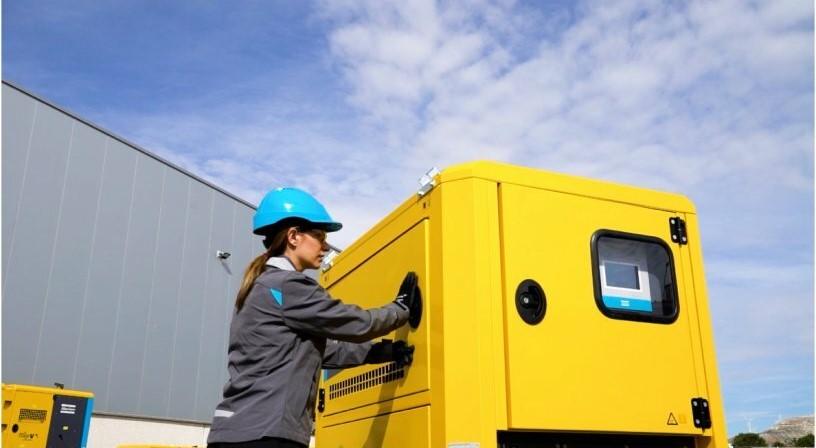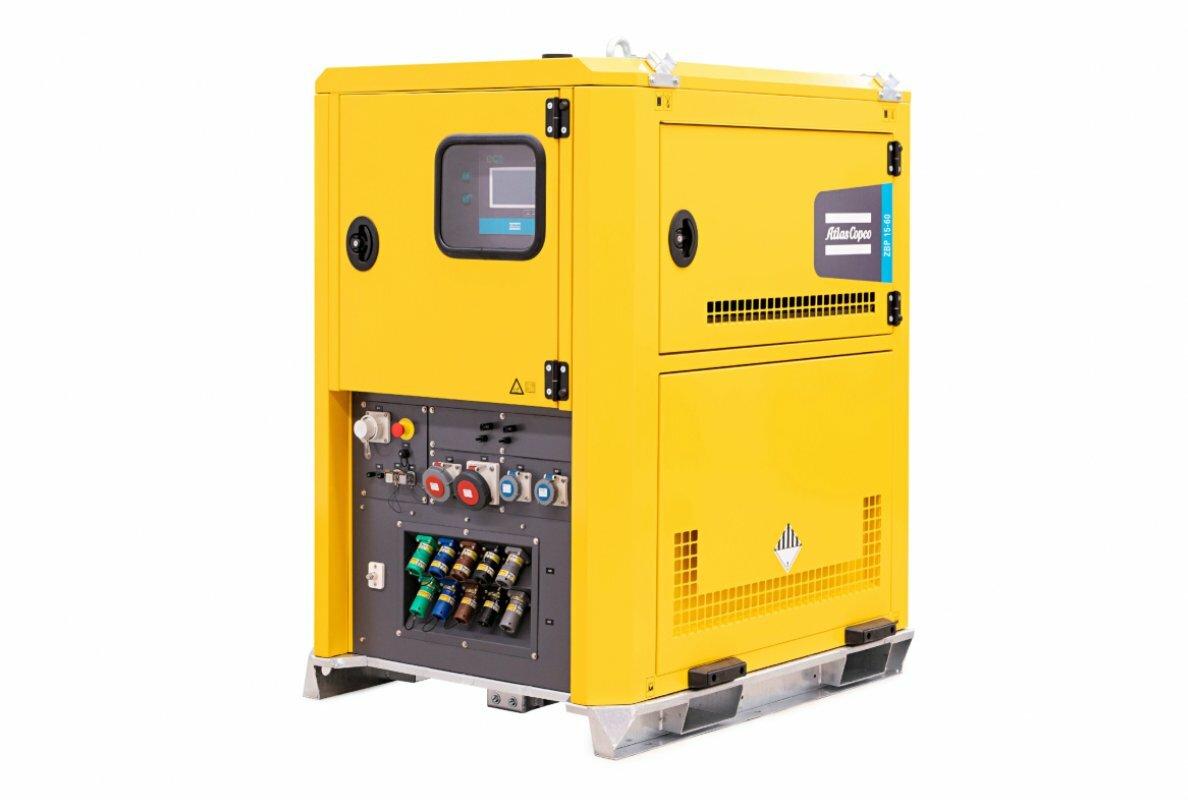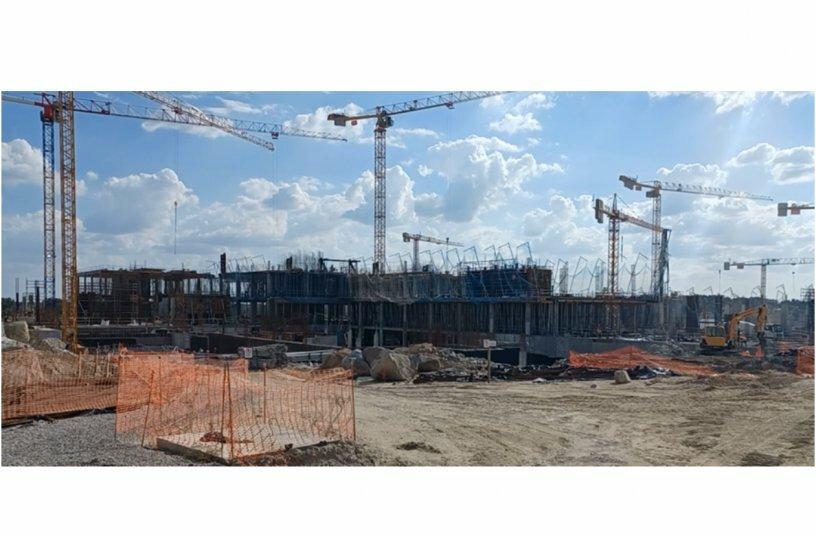Atlas Copco ZBP energy storage system optimizes electric crane use in hospital construction site
 30/11/23-FR-English-NL-footer
30/11/23-FR-English-NL-footer
Le système de stockage d'énergie Atlas Copco ZBP optimise l'utilisation des grues électriques sur les chantiers de construction d'hôpitaux


 ZBP peak shaving Portugal
ZBP peak shaving Portugal
IMAGE SOURCE: Atlas Copco
Atlas Copco a fourni un système de stockage d'énergie (ESS) ZBP fiable pour alimenter efficacement les grues sur un chantier de construction d'un hôpital dans l'Alentejo, dans le centre-sud du Portugal. ACCIONA, la multinationale espagnole qui gère le projet, a utilisé le système de stockage sur batterie pour mettre en place une solution hybride avec un générateur électrique afin d'optimiser l'empreinte environnementale du moteur électrique de la grue, réalisant ainsi d'importantes économies de carburant, d'énergie et de cycle de vie.
ACCIONA, le partenaire d'Atlas Copco dans la région, utilisait un générateur diesel comme seule source d'énergie pour la grue sur le chantier de construction d'un hôpital. Même si l'unité était capable de gérer efficacement le profil de charge et les pics de demande de puissance lorsque la grue était allumée, il est devenu évident que la solution était surdimensionnée.
Ayant un profil de charge variable, avec les pics de courant élevés et les faibles charges de la grue, le groupe électrogène devait fonctionner 24 heures sur 24, cinq jours par semaine et la plupart du temps en dehors de sa plage de fonctionnement optimale. Cela a entraîné une consommation excessive de carburant, ce qui a également eu un impact sur les coûts, des émissions supplémentaires de CO2 et de bruit, ainsi qu'un risque plus élevé de dysfonctionnement et de panne inattendue, car le moteur du générateur fonctionnait dans des conditions très exigeantes.
Après plusieurs mois d’utilisation du générateur diesel, ACCIONA a recherché une solution plus économe en énergie pour alimenter le moteur électrique de la grue.
Le système de stockage d’énergie bénéficie de batteries lithium-ion (Li-on) longue durée, nécessitant peu d’entretien et haute densité. Lorsqu'ils sont installés dans une solution hybride avec un générateur diesel, les systèmes se sont révélés idéaux pour les entreprises opérant dans des applications à faibles émissions et sensibles au bruit, comme la construction métropolitaine.
Le système de stockage d'énergie ZBP est utilisé pour couvrir les faibles charges, évitant ainsi au générateur de fonctionner dans des conditions indésirables. Au fur et à mesure que la journée de travail commence et que la demande d'énergie augmente, le générateur commence à fournir de l'énergie pendant que les batteries sont rechargées. Lorsque la grue est allumée et que la demande d’énergie atteint son maximum, les batteries chargées sont utilisées pour compléter l’alimentation du générateur afin d’alimenter efficacement le moteur électrique.
Le générateur de 75 kilowatts ne fonctionne que quatre heures tous les deux jours, lorsque le ZBP doit être rechargé. En conséquence, ACCIONA a pu augmenter ses niveaux de productivité sur site tout en limitant l'impact environnemental, en réduisant considérablement la consommation quotidienne de carburant, les émissions de CO2 et le bruit.
De plus, étant donné que les heures de fonctionnement du générateur sont réduites de plus de 50 heures par semaine à moins de 10 heures par semaine et qu'il fonctionne toujours dans la plage de fonctionnement optimale, l'unité à moteur diesel est mieux protégée et ses exigences en matière de révision et de maintenance sont minimisé. Cette configuration économe en énergie prolonge non seulement la durée de vie du générateur, mais optimise également ses performances globales.
Sur la base des résultats obtenus au cours des trois mois d'utilisation du système de stockage d'énergie Atlas Copco ZBP, ACCIONA estime les économies de 5 000 litres de carburant par an pour alimenter la grue. De plus, les coûts d'exploitation associés et les heures de fonctionnement du générateur ont été réduits jusqu'à 80 %. Cela prolongera considérablement le cycle de vie des générateurs et réduira considérablement leurs coûts de maintenance et leur impact environnemental. Dans ce cas, l’émission d’environ 15 tonnes de CO2 dans l’atmosphère chaque année sera évitée.
« Les solutions énergétiques hybrides basées sur des batteries sont essentielles à la transformation de l'alimentation électrique d'un nombre croissant de secteurs industriels, qui exigent des alternatives plus durables », déclare Victor Ghete, support technique aux ventes pour les systèmes de stockage d'énergie et les solutions hybrides chez Atlas Copco. « L'intégration du système ZBP dans la solution a amélioré la rentabilité du projet tout en réduisant considérablement l'empreinte environnementale. De plus, l’installation plug-and-play, les besoins de maintenance réduits et le système de surveillance à distance offrent à l’utilisateur final une tranquillité d’esprit.
Établir la norme en Europe du Sud
Alors que les systèmes de stockage d'énergie autonomes et les solutions hybrides sans émissions - faisant appel au réseau électrique et/ou aux énergies renouvelables - prolifèrent dans les zones où les réglementations en matière d'émissions sont plus strictes, comme la région nordique, le générateur électrique tandem ESS devient une solution d'alimentation électrique largement intégrée. en Europe du Sud, notamment sur les chantiers, les métropoles et l'événementiel.
« Nous sommes fiers de travailler avec Acciona et d'être à l'avant-garde de la transition énergétique dans le secteur de l'alimentation électrique », déclare Diego Moreno, Business Line Manager South Europe chez Atlas Copco. « Nous sommes fiers d'avoir fourni des équipements pour ce projet, qui a clairement démontré les avantages du système hybride et prouvé qu'ils font partie intégrante des chantiers cherchant à fonctionner plus efficacement.
Outre la construction du bâtiment principal de dix étages, ACCIONA réalise également l'aménagement de 127 000 m2 d'espaces verts, la construction d'un héliport et d'aires de stationnement pour 1 560 places de stationnement, ainsi que la construction des routes intérieures et une connexion avec la route principale de distribution reliant l'EN 114-Estrada de Lisboa et l'EN-380.
La construction de l'hôpital de l'Alentejo, qui aura une capacité de 400 lits, devrait s'achever en 2024."
NJC.© Info Groupe Atlas Copco
-----------------------------------------------------------------------------------------------------------------
 30/11/23-English
30/11/23-English
Atlas Copco ZBP energy storage system optimizes electric crane use in hospital construction site


 ZBP peak shaving Portugal
ZBP peak shaving Portugal
IMAGE SOURCE: Atlas Copco
Atlas Copco has supplied a reliable ZBP energy storage system (ESS) to efficiently power cranes at a construction site of a hospital in Alentejo, in southern-central Portugal. ACCIONA, the Spanish multinational company managing the project, has used the battery-based storage system to set up a hybrid solution with a power generator to optimize the environmental footprint of the crane’s electric motor, achieving significant fuel, energy and lifecycle savings.
ACCIONA, Atlas Copco’s partner in the region, had been using a diesel-driven generator as the sole source of power for the crane at the construction site of a hospital. While the unit was able to effectively handle the load profile, and peaks in power demand when the crane was turned on, it became evident that the solution was oversized.
Having a variable load profile, with the crane’s high current spikes and low loads, the power generator needed to work 24 hours a day, five days a week, and most of the time out of its optimal operational range. This resulted in excessive fuel consumption, which also impacted costs, additional CO2 and noise emissions, and a higher risk of malfunction and unexpected failure ― since the generator’s engine was operating under very demanding conditions.
After several months of using the diesel-driven generator, ACCIONA looked for a more energy-efficient solution to power the crane’s electric motor.
The energy storage system benefits from long-life, low maintenance, and high-density Lithium-ion (Li-on) batteries. When set up in a hybrid solution with a diesel-driven generator, the systems have proven to be ideal for companies operating in low-emission and noise-sensitive applications like metropolitan construction.
The ZBP energy storage system is used to cover the low loads, freeing the generator from working in undesirable conditions. As the working day begins and the power demand increases, the generator starts delivering power while the batteries are recharged. When the crane is turned on and power demand peaks, the charged batteries are used to complement the generator’s supply to efficiently power the electric motor.
The 75-kilowatt generator only runs for four hours every two days, when the ZBP needs recharging. As a result, ACCIONA was able to increase its productivity levels onsite while limiting the environmental impact, dramatically reducing daily fuel consumption, CO2 emissions and noise.
Additionally, since the generator’s running hours are reduced from over 50 hours per week to less than 10 hours per week, and it is always working within the optimal operational range, the diesel-driven unit is better protected, and its overhaul and maintenance requirements are minimized. This energy-efficient setup not only extends the generator’s lifetime but also optimizes its overall performance.
Based on the results obtained during the three months that the Atlas Copco ZBP energy storage system has been in use, ACCIONA estimates savings of 5,000 litres of fuel per year to power the crane. Also, the associated operating costs and operating hours of the generator have been reduced by up to 80%. This will significantly extend the generators' life cycle and reduce substantially their maintenance costs and environmental impact. In this case, the emission of approximately 15 tons of CO2 into the atmosphere each year will be avoided.
“Battery-based hybrid energy solutions are essential in the power supply transformation of an increasing number of industry sectors, which demand more sustainable alternatives,” says Victor Ghete, Technical Sales Support Energy Storage Systems and Hybrid Solutions at Atlas Copco. “Integrating the ZBP system into the solution has enhanced the project’s profitability while significantly reducing the environmental footprint. Additionally, the plug-and-play installation, reduced maintenance needs and the remote monitoring system provide the end-user with peace of mind.”
Setting the standard in Southern Europe
While standalone energy storage systems and emission-free hybrid solutions ― featuring the power grid and/or renewables ― are proliferating in areas with more stringent emission regulations, like the Nordic region, the tandem ESS-power generator is becoming a broadly integrated power supply solution in Southern Europe, especially in construction sites, metropolitan areas and events.
“We are proud to be working with Acciona and at the forefront of the energy transition in the power supply sector,” says Diego Moreno, Business Line Manager South Europe at Atlas Copco. “We are proud to have supplied equipment to this project, which has clearly demonstrated the advantages of the hybrid system and proven that they are integral to work sites looking to operate more efficiently.”
In addition to the construction of the ten-story main building, ACCIONA is also carrying out the development of 127,000 m2 of green areas, the construction of a heliport and parking areas for 1,560 parking spaces, as well as the construction of the interior roads and a connection with the main distributor road connecting the EN 114-Estrada de Lisboa and EN-380.
The construction of the Alentejo Hospital, which will have a capacity of 400 beds, is scheduled for completion in 2024."
NJC.© Info Atlas Copco Group
------------------------------------------------------------------------------------------------------------------
 30/11/23-NL
30/11/23-NL
Het Atlas Copco ZBP-energieopslagsysteem optimaliseert het gebruik van elektrische kranen op de bouwplaats van ziekenhuizen


 ZBP peak shaving Portugal
ZBP peak shaving Portugal
IMAGE SOURCE: Atlas Copco
Atlas Copco heeft een betrouwbaar ZBP-energieopslagsysteem (ESS) geleverd om kranen efficiënt van stroom te voorzien op een bouwplaats van een ziekenhuis in Alentejo, in het zuiden van centraal Portugal. ACCIONA, de Spaanse multinational die het project beheert, heeft het op batterijen gebaseerde opslagsysteem gebruikt om een hybride oplossing met een stroomgenerator op te zetten om de ecologische voetafdruk van de elektromotor van de kraan te optimaliseren, waardoor aanzienlijke besparingen op brandstof, energie en levenscyclus worden gerealiseerd.
ACCIONA, de partner van Atlas Copco in de regio, gebruikte een dieselaangedreven generator als enige stroombron voor de kraan op de bouwplaats van een ziekenhuis. Hoewel de unit effectief kon omgaan met het belastingsprofiel en pieken in de stroomvraag wanneer de kraan werd ingeschakeld, werd het duidelijk dat de oplossing te groot was.
Omdat de stroomgenerator een variabel belastingsprofiel had, met hoge stroompieken en lage belastingen, moest de stroomgenerator 24 uur per dag, vijf dagen per week werken en meestal buiten het optimale operationele bereik. Dit resulteerde in een overmatig brandstofverbruik, wat ook gevolgen had voor de kosten, extra CO2- en geluidsemissies en een groter risico op storingen en onverwachte storingen – aangezien de motor van de generator onder zeer veeleisende omstandigheden draaide.
Na enkele maanden de dieselaangedreven generator te hebben gebruikt, zocht ACCIONA naar een energiezuinigere oplossing om de elektromotor van de kraan aan te drijven.
Het energieopslagsysteem profiteert van lithium-ion (Li-on) batterijen met een lange levensduur, weinig onderhoud en een hoge dichtheid. Wanneer ze worden opgezet in een hybride oplossing met een dieselaangedreven generator, zijn de systemen ideaal gebleken voor bedrijven die actief zijn in emissiearme en geluidsgevoelige toepassingen zoals de grootstedelijke bouw.
Het ZBP-energieopslagsysteem wordt gebruikt om de lage belastingen te dekken, waardoor de generator niet onder ongewenste omstandigheden kan werken. Naarmate de werkdag begint en de vraag naar stroom toeneemt, begint de generator stroom te leveren terwijl de batterijen worden opgeladen. Wanneer de kraan wordt ingeschakeld en de vraag naar stroom piekt, worden de opgeladen batterijen gebruikt als aanvulling op de voeding van de generator om de elektromotor efficiënt van stroom te voorzien.
De generator van 75 kilowatt draait slechts vier uur per twee dagen, wanneer de ZBP moet worden opgeladen. Als gevolg hiervan was ACCIONA in staat om de productiviteit op locatie te verhogen en tegelijkertijd de impact op het milieu te beperken, waardoor het dagelijkse brandstofverbruik, de CO2-uitstoot en het lawaai dramatisch werden verminderd.
Omdat de draaiuren van de generator zijn teruggebracht van meer dan 50 uur per week naar minder dan 10 uur per week en de generator altijd binnen het optimale operationele bereik werkt, is de dieselaangedreven unit bovendien beter beschermd en zijn de revisie- en onderhoudsvereisten lager. geminimaliseerd. Deze energiezuinige opstelling verlengt niet alleen de levensduur van de generator, maar optimaliseert ook de algehele prestaties.
Op basis van de resultaten die zijn verkregen gedurende de drie maanden dat het Atlas Copco ZBP-energieopslagsysteem in gebruik is geweest, schat ACCIONA een besparing van 5.000 liter brandstof per jaar om de kraan aan te drijven. Bovendien zijn de daarmee samenhangende bedrijfskosten en bedrijfsuren van de generator tot wel 80% verlaagd. Dit zal de levenscyclus van de generatoren aanzienlijk verlengen en de onderhoudskosten en de impact op het milieu aanzienlijk verminderen. In dit geval wordt de uitstoot van ongeveer 15 ton CO2 in de atmosfeer per jaar vermeden.
“Op batterijen gebaseerde hybride energieoplossingen zijn essentieel in de energievoorzieningstransformatie van een toenemend aantal industriële sectoren, die duurzamere alternatieven eisen”, zegt Victor Ghete, Technical Sales Support Energy Storage Systems and Hybrid Solutions bij Atlas Copco. “De integratie van het ZBP-systeem in de oplossing heeft de winstgevendheid van het project vergroot en tegelijkertijd de ecologische voetafdruk aanzienlijk verkleind. Bovendien zorgen de plug-and-play-installatie, de verminderde onderhoudsbehoeften en het systeem voor monitoring op afstand ervoor dat de eindgebruiker gemoedsrust heeft.”
De standaard zetten in Zuid-Europa
Terwijl stand-alone energieopslagsystemen en emissievrije hybride oplossingen – met het elektriciteitsnet en/of hernieuwbare energiebronnen – zich steeds meer verspreiden in gebieden met strengere emissievoorschriften, zoals de Scandinavische regio, wordt de tandem-ESS-stroomgenerator een breed geïntegreerde stroomvoorzieningsoplossing in Zuid-Europa, vooral op bouwplaatsen, grootstedelijke gebieden en evenementen.
“We zijn er trots op samen te werken met Acciona en voorop te lopen in de energietransitie in de energievoorzieningssector”, zegt Diego Moreno, Business Line Manager Zuid-Europa bij Atlas Copco. “We zijn er trots op dat we apparatuur aan dit project hebben geleverd, die duidelijk de voordelen van het hybride systeem heeft aangetoond en heeft bewezen dat ze een integraal onderdeel zijn van werkplekken die efficiënter willen werken.”
Naast de bouw van het tien verdiepingen tellende hoofdgebouw voert ACCIONA ook de ontwikkeling uit van 127.000 m2 groenvoorzieningen, de aanleg van een helihaven en parkeerterreinen voor 1.560 parkeerplaatsen, evenals de aanleg van de binnenwegen en een verbinding met de hoofdontsluitingsweg die de EN 114-Estrada de Lisboa en EN-380 verbindt.
De bouw van het Alentejo-ziekenhuis, dat een capaciteit zal hebben van 400 bedden, zal naar verwachting in 2024 voltooid zijn.
NJC.© Info Atlas Copco Groep
--------------------------------------------------------------------------------------------------------------------
Date de dernière mise à jour : 29/11/2023
















